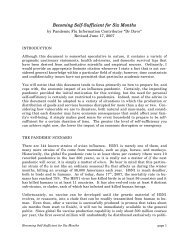Create successful ePaper yourself
Turn your PDF publications into a flip-book with our unique Google optimized e-Paper software.
BLACK SPORE PRINT<br />
chiefly on the decaying wood of the roots, and it is not uncommon<br />
for six or eight successive crops to appear each summer for<br />
several years. At Geneva, New York, a mycologist harvested ten<br />
crops from one elm stump during the spring and summer, some<br />
of these being induced to appear by watering the soil around the<br />
stump in periods of dry weather. The total weight of these ten<br />
crops was slightly more than thirty-eight pounds. Some maintain<br />
that this fungus can anticipate rain and will start to grow a day<br />
or two before the rain comes, doubtless because of the high humidity<br />
at that time.<br />
The cap is at first conical, from i to 2 inches wide at the base,<br />
tan in moist weather but becoming nearly white when dried out,<br />
sometimes covered with exceedingly small, shiny particles and<br />
marked with furrows running from the margin up almost to the<br />
center. The gills are between 1/8 and 1/4 inch wide. The stem is<br />
about 1/8 inch wide and 2 or 3 inches long and is white and<br />
brittle.<br />
It has been suggested that the spores of this and certain other<br />
fungi might be added to ink used in signing important documents,<br />
since a microscopic examination of the dried ink would<br />
reveal its identity and forgery would be unlikely, unless the forger<br />
was also a mycologist! This fungus, as well as all other species of<br />
Coprinus, is said to be digested more easily than most other kinds<br />
of mushrooms, since it is almost completely liquefied by its own<br />
enzymes, but it could scarcely be considered a sustaining food.<br />
GENUS Panaeolus<br />
<strong>Edible</strong> but not recommended: PANAEOLUS<br />
SOLIDIPES<br />
The genus Panaeolus is known by (i) black spores and (z)<br />
gills that do not liquefy, as they do in Coprinus. This species<br />
(Figures 53 and 54) is the only one of sufficient size and prevalence<br />
to justify inclusion here. It is a spring mushroom com-<br />
83
















